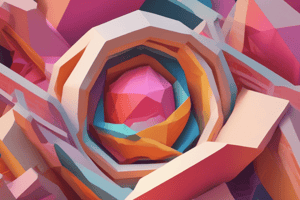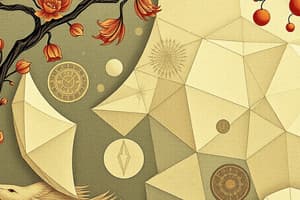Podcast
Questions and Answers
What type of cross-section is created when a plane intersects a cylinder parallel to one of its bases?
What type of cross-section is created when a plane intersects a cylinder parallel to one of its bases?
- Triangle
- Circle (correct)
- Square
- Rectangle
When a cone is cut by a plane intersecting its base, what shape does the resulting cross-section have?
When a cone is cut by a plane intersecting its base, what shape does the resulting cross-section have?
- Triangle
- Circle (correct)
- Square
- Pentagon
What is the shape of the cross-section when a cone is cut by a plane that intersects its vertex?
What is the shape of the cross-section when a cone is cut by a plane that intersects its vertex?
- Ellipse
- Circle (correct)
- Parabola
- Rectangle
Which figure always creates an elliptical cross-section when cut at an angle?
Which figure always creates an elliptical cross-section when cut at an angle?
What is the main purpose of slicing three-dimensional figures?
What is the main purpose of slicing three-dimensional figures?
How does slicing along different planes help in exploring three-dimensional figures?
How does slicing along different planes help in exploring three-dimensional figures?
What is the purpose of slicing three-dimensional figures?
What is the purpose of slicing three-dimensional figures?
How are parallel cuts defined in slicing three-dimensional figures?
How are parallel cuts defined in slicing three-dimensional figures?
What shapes can result from intersecting cuts in three-dimensional figures?
What shapes can result from intersecting cuts in three-dimensional figures?
Which of the following is true about parallel cuts in slicing three-dimensional figures?
Which of the following is true about parallel cuts in slicing three-dimensional figures?
If a plane for slicing is tilted 45 degrees, what shape will the resulting cross-section have?
If a plane for slicing is tilted 45 degrees, what shape will the resulting cross-section have?
What defines intersecting cuts in slicing three-dimensional figures?
What defines intersecting cuts in slicing three-dimensional figures?
Study Notes
Slicing Three-Dimensional Figures
Slicing three-dimensional figures involves cutting through different surfaces of a solid figure using planes. This process can reveal hidden sections of the figure, making it easier to understand its structure. In this article, we will discuss how slicing works and illustrate some examples.
Types of Cuts
There are two ways to slice a three-dimensional figure: by parallel cuts and by intersecting cuts. These methods allow us to explore various aspects of the object's shape and volume.
Parallel Cuts
Parallel cuts involve cutting along straight lines that are perpendicular to the axis of rotation. This means that all points on each line lie at equal distances from the center of rotation. When you make parallel cuts along multiple pairs of parallel planes, you create a series of flat cross-sectional shapes called slices or disks. Examples of parallel cuts could be along the xy-plane, yz-plane, or xz-plane.
Intersecting Cuts
Intersecting cuts occur when a plane does not pass through the center of rotation, creating an angle between the cross-sections. Instead of being circular cross-sections, these slices are elliptical or other non-circular shapes. For example, if the plane is tilted 45 degrees, the resulting cross-section would be a rectangle with rounded corners.
Examples of Slicing Three-Dimensional Figures
Slicing a Cylinder
A cylinder is a three-dimensional figure with two parallel, congruent circular bases connected by a curved surface. To slice a cylinder, you can use a plane that is parallel to one of its bases. By doing so, you will create a cross-section that is a circle. If the plane intersects the cylinder at an angle, you will create an elliptical cross-section.
Slicing a Cone
A cone is a three-dimensional figure with a circular base and a vertex at the center. The cross-section of a cone is always a circle. If you cut a cone with a plane that intersects the base, the resulting cross-section will be a circle. If the plane crosses the vertex of the cone, the cross-section will be a smaller circle.
Conclusion
Slicing three-dimensional figures helps us to visualize their shapes and understand their structures. By cutting along different planes, we can explore various aspects of the object's geometry and volume. The process of slicing can be done using parallel cuts or intersecting cuts, each revealing different information about the figure.
Studying That Suits You
Use AI to generate personalized quizzes and flashcards to suit your learning preferences.
Description
Learn about the process of slicing three-dimensional figures using planes to reveal hidden sections and understand their structure. Explore the types of cuts such as parallel cuts and intersecting cuts, and see examples of slicing cylinders and cones.




